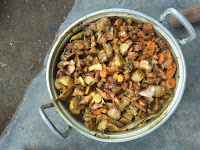Come,
See, Practice and I Can!
Follow-up group of NTT students
 Human have thought and curiosity, so they will try to find out
answers of questions bothering their mind until the answers
are gained. Feeling
of curiousity also
covered the participants’ mind of Stube-HEMAT Yogyakarta after Organic Farming training
held on May
4-6, 2018,
especially when they followed
a session delivered by
TO Suprapto, one of the facilitators explaining about an integrated agriculture system
and the utilization of
local materials for liquid fertilizer.
Human have thought and curiosity, so they will try to find out
answers of questions bothering their mind until the answers
are gained. Feeling
of curiousity also
covered the participants’ mind of Stube-HEMAT Yogyakarta after Organic Farming training
held on May
4-6, 2018,
especially when they followed
a session delivered by
TO Suprapto, one of the facilitators explaining about an integrated agriculture system
and the utilization of
local materials for liquid fertilizer.
Filled with passion and
strong motivation to learn, five students (originally from NTT)
went to Godean, precisely to Joglo Tani owned by TO Suprapto to explore the
process of liquid fertilizer on Wednesday, May 23, 2018. They are children of farmers actually, but they do not know how to make liquid
fertilizer made from local material because they rarely use it as fertilizer. They hoped that they can
apply the fertilizer when they return home. They are Bram (an
agricultural student),
Daniel (a student of governmental sciences), Chindy Rawambaku (a civil engineering student) and
Elisabeth Uru Ndaya (an English Education student) from Sumba and Ikha (a Psychology student from Soe).
Activities in Joglo Tani
was began from a visit to the liquid and solid fertilizer production. There, the participants discussed with
Bowo, TO Suprapto’s younger brother, about rabbit's urine as an example of liquid
fertilizer, as well as the practice of the students about some ingredients of liquid fertilizer, the
measurement, until being
ready to be fermented.
They practiced to make it together with vocational students who were also studying there
at the same time.
 The ingredients of liquid
fertilizer are 20 liters of cow urine, 2 kilograms of herbal
substances called ‘empon-empon’, some otten fruits, 1 liter of
molasses, 2 kgs guano
kohe, gamal leaves and banana stems. The following is
the way how to make it: ‘empon-empon’ are sliced and boiled, after
boiling, the ingredients are cooled and mixed with cow urine, molasses, rotten
fruits, gamal leaves, and chopped banana stems. The mixture were put in a
bucket and sealed for about two weeks for fermentation. After two weeks, the
liquid fertilizer is completed
and ready to use. If there is no cow urine, coconut
water can be used instead, and mollases can be replaced with brown sugar.
Liquid fertilizer is useful to increase soil nutrition because it
contains organic
nutrients to refresh plants. Other benefit of using ‘empon-empon’ is killing pests in the soil because
it tends to heat.
The ingredients of liquid
fertilizer are 20 liters of cow urine, 2 kilograms of herbal
substances called ‘empon-empon’, some otten fruits, 1 liter of
molasses, 2 kgs guano
kohe, gamal leaves and banana stems. The following is
the way how to make it: ‘empon-empon’ are sliced and boiled, after
boiling, the ingredients are cooled and mixed with cow urine, molasses, rotten
fruits, gamal leaves, and chopped banana stems. The mixture were put in a
bucket and sealed for about two weeks for fermentation. After two weeks, the
liquid fertilizer is completed
and ready to use. If there is no cow urine, coconut
water can be used instead, and mollases can be replaced with brown sugar.
Liquid fertilizer is useful to increase soil nutrition because it
contains organic
nutrients to refresh plants. Other benefit of using ‘empon-empon’ is killing pests in the soil because
it tends to heat.
Bram Mila, one of the
participants said, "I got impression how to make the POC (Liquid Organic Fertilizer).
It is very easy and
cheap for the material, because all plants around us can be used as fertilizer
or insecticide. Now I can make POC with turmeric and ginger, one kg
for each".
It has been proven that learning
process by coming, seeing, and
practicing will make
someone master better. Therefore, young
people, let’s begin to recognize local materials in your area and use them to increase the
production
of community agriculture.
(ELS).










This is aweesome
ReplyDelete